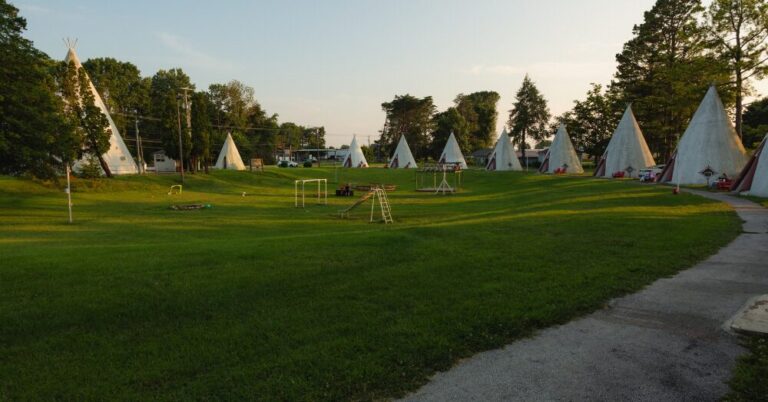Picture this: you’re burying a dead pig on a hot August day in 1926, and your shovel hits something hard. You dig deeper, expecting maybe a rock or tree root. Instead, you uncover a massive skull with a five-foot-long tusk staring back at you. This is exactly what happened to one farmer in Ohio, and it changed everything.
- Tenant farmer James Bailey discovered the most complete mastodon skeleton ever found in Ohio while trying to bury a deceased hog on August 12, 1926
- The Johnstown Mastodon turned out to be a 19-year-old male that lived over 12,000 years ago and stood nearly 9 feet tall
- After creating a tourist sensation that drew over 8,000 visitors in a single day, the skeleton was sold to Cleveland Museum of Natural History for $5,300
The Strangest Burial Job in History
James Bailey had one simple job that sweltering day in Johnstown: dig a hole and bury Friend Butt’s prized sow that had died. Bailey was working as a tenant farmer on Butt’s property, and this seemed like any other unpleasant farm chore. He grabbed his shovel and headed to the swampy corner of the property, figuring the soft ground would make digging easier.
A few feet down, his shovel struck something solid. Bailey probably muttered a few choice words, thinking he’d hit a boulder. But as he cleared away the mud and muck, he realized this wasn’t any ordinary rock. What emerged was a massive skull with what looked like an enormous tooth sticking out of it.
The local newspaper reported that Bailey kept digging and found “bone after bone” that were “somewhat out of size compared with animals known to Bailey.” Some appeared to be rib bones three to four feet long. The farmer had stumbled upon something that had been sleeping in that Ohio bog for over 12,000 years.
From Farm Field to Scientific Sensation
Word spreads fast in small towns, and news of Bailey’s bizarre discovery reached the ears of people who actually knew what they were looking at. Kirtley F. Mather, head of Harvard University’s geology department, made the trip to examine the bones personally. What he found left him speechless.
This wasn’t any old fossil – it was one of the most complete mastodon skeletons ever discovered. The young male had died around 19 years old, standing nearly 9 feet tall and weighing close to 8,000 pounds. Its tusk measured an impressive five feet long with a 22-inch circumference at the base. Over 90% of the skeleton remained intact, preserved perfectly by the swampy conditions that had protected it for thousands of years.
Professor Mather declared it one of the most perfect specimens he’d ever seen, immediately putting to rest early theories that the bones belonged to a circus elephant that had wandered off and died.
The Greatest Show on Earth (or at Least in Ohio)
Friend Butt, the farm owner, quickly realized he was sitting on something valuable. But first, he had to deal with the chaos. When news broke about the mastodon discovery, thousands of curious visitors descended on his property. On the busiest day, over 8,000 people showed up to gawk at the ancient bones.
Being a shrewd businessman, Butt decided to cash in. He erected a wooden enclosure around the excavation site, set up electric searchlights, hired barkers with flashy signs, and started charging 25 cents per person to view what he advertised as the “unknown pre-historic monster.” The humble farm looked like an oil boom had struck it, complete with concession stands and crowds that stretched as far as the eye could see.
Max Hirschberg, a Newark businessman, eventually bought the skeleton from Butt for $5,000 cash. Hirschberg funded the careful excavation process, which had to be done entirely by hand to avoid damaging the delicate bones. Workers spent days carefully removing each piece from the bog-like conditions that had preserved them so well.
A New Home for an Ancient Giant
The Johnstown Mastodon’s story didn’t end with its discovery. M.F. Bramley, president of the Cleveland Trinidad Paving Company, stepped in with a generous donation that allowed the Cleveland Museum of Natural History to acquire the skeleton for $5,300 in December 1926.
The museum carefully reconstructed the massive skeleton, allowing visitors to come face-to-face with a creature that once roamed the forests of prehistoric Ohio. For decades, the Johnstown Mastodon stood as one of the museum’s most popular exhibits, drawing scientists, students, and curious families from around the world.
As one newspaper writer put it, visitors came “from foreign lands, scientists from different cities, students from educational institutions everywhere” to see what was considered the finest and most completely preserved remains of these Ice Age giants.
When Giants Walked Ohio
The Johnstown discovery gives us a window into a completely different Ohio. During the late Pleistocene Epoch, over 10,000 years ago, the area looked nothing like today’s farms and cities. Vast forests covered the land, and mastodons wandered freely through woodlands, munching on twigs, leaves, and bark.
These ancient giants were perfectly adapted to their environment. Unlike their mammoth cousins who preferred open grasslands, mastodons thrived in forested areas. They used their powerful tusks to strip bark from trees and their strong teeth to grind tough plant material.
The swampy conditions where Bailey made his discovery were likely what killed the young mastodon in the first place, but they also provided the perfect preservation environment. When the animal died, possibly from old age or environmental factors, the wet, oxygen-poor soil created a natural seal that protected the bones from decay for thousands of years.
A Legacy That Lives On
Today, you can visit the site where this remarkable discovery took place. The Mastodon Preserve, located at Johnstown Trailhead Park, marks the spot where Bailey’s simple burial job turned into one of the most important paleontological finds in Ohio history.
The Cleveland Museum of Natural History still houses the Johnstown Mastodon, though the museum has undergone recent renovations. The Kirtland Hall of Prehistoric Life, where the mastodon was displayed, has been temporarily closed to the public during construction work.
James Bailey probably never imagined that his worst day at work would become one of the most celebrated discoveries in Ohio’s history. What started as a routine farm chore turned into a scientific sensation that continues to educate and inspire visitors nearly a century later.
The next time you’re doing yard work and hit something unexpected with your shovel, remember Bailey’s story. You never know what might be hiding beneath your feet – especially in a state like Ohio, where prehistoric giants once roamed freely through ancient forests.






